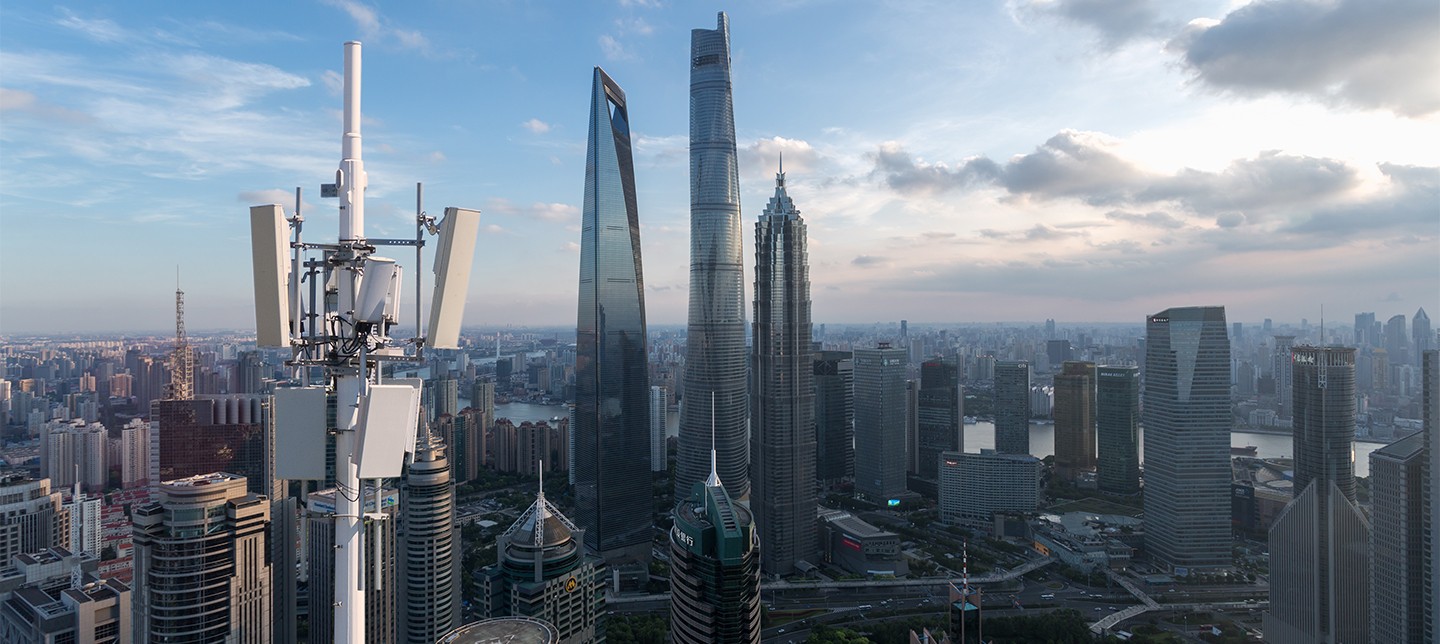
How Cell Towers Work to Keep You Connected
BUSINESS INSIGHT
5G AND 6G TECHNOLOGY | 13 MINUTE READ
Cell towers make wireless communication networks possible. Here’s the technology & engineering that underpins so much of our world today.
Cell towers consist of various components such as antennas, base transceiver stations, masts, and ground-based equipment, enabling efficient cellular communication by managing signals from mobile devices. The distinction between 4G and 5G towers lies in improved speed, capacity, and latency provided by 5G technology. Thorough testing ensures optimal performance and reliability of these towers.
NI is Helping Build a Reliable Wireless Infrastructure
Our world is more connected than ever, and it takes a tremendous amount of resources to keep the networks we all rely on stable. Cell towers, also commonly referred to as cell sites or base transceiver stations, are crucial components of modern telecommunication systems. The physical structure holds necessary equipment for the transmission and reception of radio signals for a specific "cell" or area, hence the name. Cell towers facilitate wireless communication between mobile devices and the network. These structures play an indispensable role in the wireless communication ecosystem, enabling us to make calls, send texts, and access the internet from our mobile devices—and they require intensive testing.
By providing flexible, scalable, and cost-effective solutions for the testing of new, complex technologies, NI contributes significantly towards building reliable wireless infrastructures. As wireless technologies evolve and grow more intricate, particularly relevant with the advent of 6G, innovative solutions will help test engineers build an advanced understanding of the network design and test technology necessary to maintain cell tower uptime.
Cell Tower Components
If you scan the horizon, it's almost certain you'll spot a cell tower, even if you don’t immediately recognize it. Base transceiver stations come in a wide variety of sizes from familiar tall towers to small units not much larger than a smoke detector. It all depends on the coverage needed and traffic density in the area.
But what does a cell tower look like? Cell towers resemble tall, vertical masts adorned with arrays of antennas, typically segmented into three or four directions, giving them a distinct, recognizable silhouette. However, not all cell towers stand out so clearly. Stealth towers are more covert, camouflaged within their environment, discreetly incorporated into existing structures such as rooftops or even church steeples. Whether they're immediately recognizable or subtly blended into their surroundings, these towering structures are packed with a range of critical equipment that ensures seamless cellular connectivity across the area they serve.
While each cell tower may be slightly different, depending on the needs of the network and the specific area it serves, these components are typically present in most installations:
- Antennas—These are crucial for transmitting and receiving signals to and from mobile devices within a specific cell. They come in two main cell tower antenna types:
- Panel Antennas—These are flat, rectangular devices that serve a wide area. They are versatile and can be arranged in various configurations to achieve desired coverage and capacity. They can use MIMO (Multiple Input, Multiple Output) technology, which increases capacity by transmitting several data streams on the same channel.
- Sector Antennas—Often grouped in threes or fours on a tower, sector antennas are designed to provide coverage in a specific direction or "sector." This segmentation effectively broadens the overall coverage area and reduces interference between signals. They're often arranged in a geometric configuration, providing 360-degree coverage.
- Base Transceiver Station (BTS) —The BTS houses the radio transceivers that receive and transmit RF signals. Each transceiver or channel supports a certain number of concurrent calls. The BTS also includes equipment for encrypting and decrypting communications, spectral filtering tools, duplexers, and amplifiers.
- Tower or Mast—This tall physical structure holds the antennas aloft and is typically made of steel. Its height is strategic: the higher the antennas, the broader the area they can cover. The structure must also be able to withstand environmental stressors like wind and weight load from the equipment.
- Ground-Based Equipment—This includes enclosures or shelters that house various auxiliary systems such as cell tower power systems (often battery backups for reliability), HVAC systems for temperature control, and baseband receivers used for processing call data.
- Microwave Dishes—For cell towers not connected with physical cable to the telecommunications network (usually in remote locations), microwave dishes are used for backhaul connections. These dishes facilitate point-to-point communication with other towers or a network node. They are often seen on the sides of the tower and are particularly useful in areas where it is impractical to run cables.
- Cabling—Cabling connects all the components of the cell tower, allowing them to communicate with each other. Cabling can include various types, such as coaxial cables, waveguides for microwave transmission, and fiber optic cables. RF cables run from the BTS to the antennas and network cables for data transmission.
The seamless orchestration of these cell tower components underpins the backbone of wireless communications networks.
How Do Cell Towers Work?
Cell towers serve as the intermediary between mobile devices and the telecommunications network. In layman's terms, cell towers work by receiving signals from your mobile device, converting these signals into a digital format, and then sending them along to their destination, either to another phone or onto the internet. For incoming calls or data, the process is reversed. That process may sound simple, but it has many steps and pieces of equipment. Let’s get into the details.
The communication process begins when a mobile device, such as a cell phone, sends a signal. This signal is an electromagnetic wave, specifically a RF wave, which is essentially a modulated version of the user's voice or data. The signal is picked up by one of the antennas mounted on the mast. These antennas can use MIMO technology, transmitting multiple data streams on the same channel to increase capacity.
After the antenna receives the signal, it is passed through a series of high-frequency coaxial cables or waveguides to the BTS housed at the base of the tower. The BTS converts the RF signal into a digital format that can be processed by the network. The processed signal is then dispatched to the mobile switching center (MSC) through backhaul connections. Depending on the location and infrastructure, this connection could be physical, such as through fiber optic cables (for urban or suburban areas), or wireless like microwave links (for remote areas).
The MSC, the nerve center of a cellular network, then routes the call or data to the correct destination, which could be another mobile device or a server on the internet. For an incoming call or data, the process is essentially reversed. The MSC dispatches the signal to the BTS, which then upconverts it back to an RF signal. This RF signal is then transmitted by the tower's antennas to the intended mobile device.
How Far Do Cell Tower Signals Reach?
A cell tower can send signals to phones up to 20 miles away in rural areas. In densely populated cities with many physical obstructions like buildings, the range might be reduced to a mile or two. Cell towers can handle thousands of calls or internet connections at the same time.
When looking at how far cell towers reach, the range, technically referred to as the cell radius, can be significantly impacted by several factors. High frequency signals, such as those typically used in 5G networks, tend to have shorter ranges but higher capacities, while lower frequencies, often used in rural areas for 4G LTE, can travel further but carry less data. The height and type of the antenna also play an integral role in determining the coverage. Higher antennas can overcome obstructions and cover a larger area. Antenna types such as sector antennas can be used to provide targeted coverage in specific directions, while panel antennas offer broad coverage. Beamforming, a technique used in advanced MIMO setups, can also be employed to focus the signal toward specific users to extend the range and improve signal quality.
To cover thousands of simultaneous requests, modern cell towers employ sophisticated technologies to maximize the number of concurrent calls or data sessions. MIMO allows for the simultaneous transmission and reception of multiple data streams, effectively multiplying the capacity without requiring additional bandwidth. Advanced spectral efficiency techniques, such as quadrature amplitude modulation (QAM), are also employed to transmit more bits per Hz of bandwidth. The specific technology used changes capacity. mmWave technology offers room for higher bandwidths which in turn can increase capacity significantly. Additionally, the range of frequencies allocated for cell use in a specific area, also known as the amount of available spectrum, can affect capacity.
Line of Sight in Wireless Communication
In wireless communication, line of sight refers to the direct, unobstructed path that radio waves travel from the transmitting antenna, such as a cell tower, to the receiving antenna, which could be something like a smartphone.
For optimal signal strength and quality, a clear line of sight between the transmitter and receiver is important Obstructions like buildings, trees, hills, or even atmospheric conditions can cause signal attenuation, or weakening, and multipath propagation, where signals bounce off surfaces and arrive at the receiver at different times, potentially causing interference and degraded performance.
Line of sight becomes especially important in higher frequency bands,like those used in 5G networks, which have shorter wavelengths and are more prone to be absorbed or reflected by obstacles. Line of sight is why you often see cell towers placed high above ground level and why technologies like beamforming are used to focus the radio signal in a specific direction towards the receiver.
Types of Cell Towers
Cell towers vary based on their construction, location, and the type of technology they use. The most common types of towers include monopole cell towers, lattice towers, guyed towers, stealth towers, rooftop towers, and small cell towers.
Monopole Tower
The simplest type of cell tower is also the one that is most commonly used, particularly in urban areas. A monopole tower is a single, freestanding pole that typically stands between 50-200 feet tall. The antennas are usually located at the top inside a canister or are mounted on the exterior.
Lattice Tower
These towers are often seen in the countryside or along highways. Stronger than monopole towers, they can support more equipment and reach greater heights. Lattice towers are freestanding and feature a framework of horizontal and diagonal rods creating a lattice effect.
Guyed Tower
These towers are often seen in the countryside or along highways. Stronger than monopole towers, they can support more equipment and reach greater heights. Lattice towers are freestanding and feature a framework of horizontal and diagonal rods creating a lattice effect.
Stealth Tower
Like their name suggests, stealth or concealed towers are built to blend in with their surroundings. They may be designed to look like trees (often called "monopines"), clock towers, flag poles, church steeples, or even incorporated into existing structures like buildings or signage.
Rooftop Tower
In densely populated urban areas, it may not be practical or possible to build a freestanding tower. In these cases, antennas may be installed on the roofs of buildings or other existing structures. These installations can be much lower in height than traditional towers but often need to be more densely placed to provide sufficient coverage.
Small Cell Towers
With the advent of 5G technology, small cell towers are becoming increasingly common. These small cells called micro-, pico-, or femto-cells have a shorter range but can quickly transmit large amounts of data. Small cell towers are often attached to streetlights, utility poles, or buildings in high-density areas.
These different types of cell towers all serve the same basic purpose—to transmit and receive signals from mobile devices. The exact type of tower used depends on a variety of factors such as geography, population density, and the specific requirements of the mobile network.
4G vs. 5G Cell Towers
The primary distinctions between 4G and 5G cell towers revolve around the changes in technology that affect the speed, capacity, and latency of the wireless network. 4G networks typically operate on lower frequency bands, up to 2.5 GHz, while 5G technology is designed to employ a wider spectrum, incorporating higher frequency bands up to 100 GHz. The use of these higher frequencies, particularly the millimeter-wave bands over 24 GHz, can facilitate faster network transmission, but with less range.
One of the most noteworthy differences is data transfer rates. 5G cell towers can deliver significantly higher data speeds than their 4G counterparts. To put this into perspective, while 4G LTE networks can provide peak speeds around 100 Mbps, 5G networks have the theoretical potential to deliver speeds up to 10 Gbps, a hundredfold increase.
Latency, or the delay in data transfer following an instruction for its transfer, is another area where 5G excels. Compared to the typical latency of around 50 milliseconds on 4G networks, 5G aims to reduce this to just a few milliseconds, which is particularly important for real-time applications, such as autonomous vehicles. 5G technology requires a higher density of cell towers, especially in areas of high population density or for indoor coverage, because of the shorter range of the higher frequencies. To solve this challenge, small cell towers are used to augment coverage and capacity.
Compared to 4G towers, 5G ones incorporate many more antennas on a single tower, known as Massive MIMO (Multiple Input Multiple Output), to enhance the capacity and efficiency of the network. They also utilize a technique called beamforming, which focuses the wireless signal in a specific direction rather than indiscriminately broadcasting in all directions like 4G cell towers. This approach helps improve cell tower signal strength and diminish interference.
Despite their differences, it's worth noting that 4G and 5G technologies aren't mutually exclusive. The majority of 5G networks share their backhaul and entire network structure with 4G, differing only in the wireless interface. These types of deployments are typically referred to as NSA (Non-Stand Alone) networks. The popularity of NSA networks is largely because all components, except for the base station, can be reused, thus reducing the cost of network construction. There are also stand-alone, or SA networks, which could potentially offer better capacity, but these necessitate building all network components from scratch, making them significantly more expensive to construct. As such, most devices can switch between 4G and 5G as required in NSA networks.
Cell Tower & Wireless Infrastructure Testing
Test is critical for the reliability of cell tower infrastructure as it allows for the identification and rectification of potential issues, ensuring optimal performance, continuous uptime, and the provision of robust, seamless wireless connectivity to users. O-RAN test, which evaluates the performance and interoperability of Open Radio Access Network components, is especially crucial in ensuring the seamless functioning of advanced cellular networks.
NI plays a pivotal role in the testing of cell tower components by offering flexible, scalable, and cost-effective solutions. As wireless technologies advance and become more complex, particularly with the emergence of 6G, there's an increased demand for innovative test solutions. NI responds to this need by amalgamating high-quality RF measurements with its extensive expertise in wireless communications testing.
In recent times, the shift from proprietary protocols to standard interfaces in the disaggregation of base station components has necessitated specialized in-the-loop tests and emulations. NI steps up to this demand by offering these specialized tests, facilitated by high-quality RF measurements. A partnership with NI ensures robust test solutions grounded in decades of wireless industry experience. Learn more about fast and connected wireless infrastructure development.

